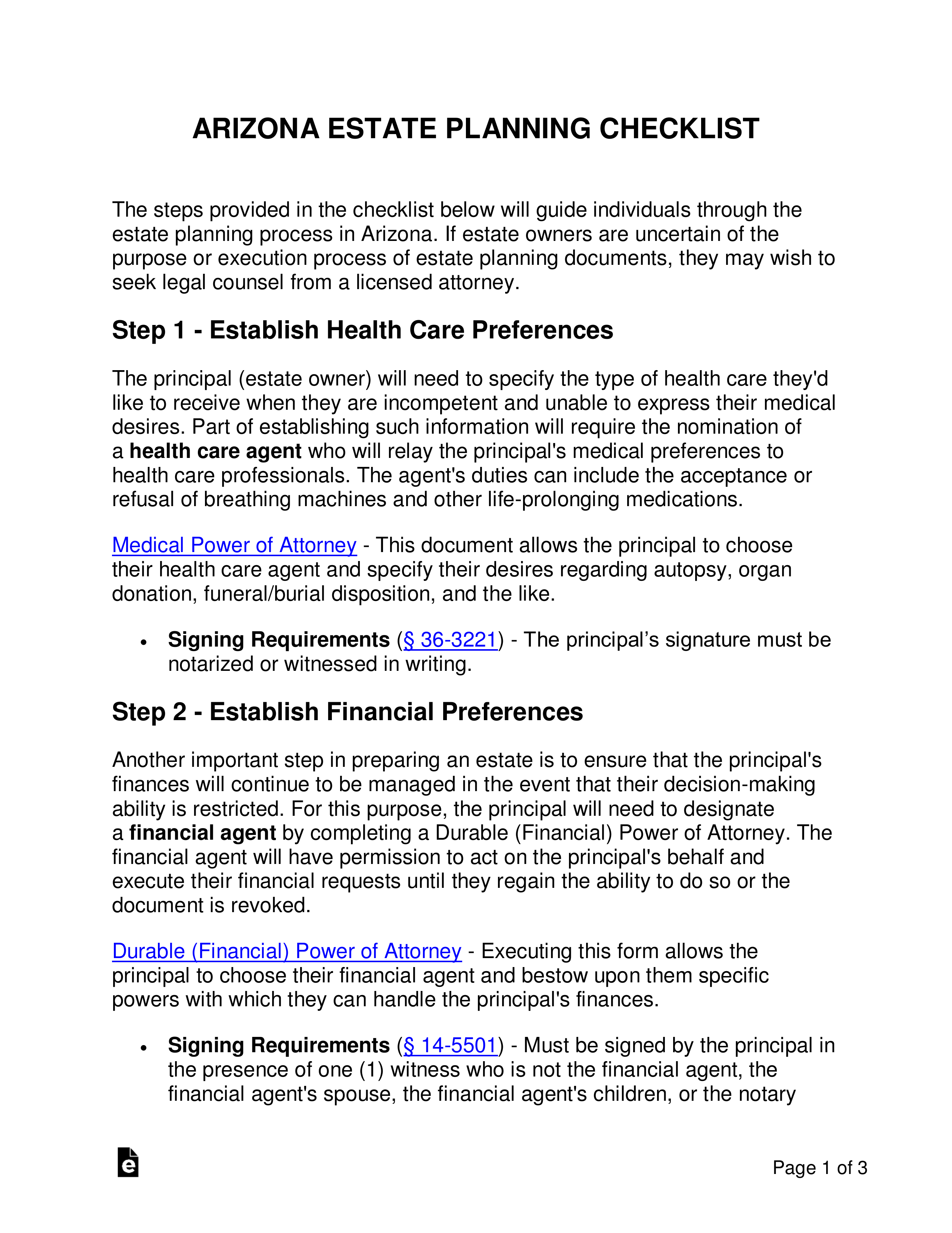Updated March 05, 2024
An Arizona estate planning checklist provides a list of documents that allow an individual to give authority to “agents” to manage their finances, medical decisions, and other end-of-life affairs. It helps people prepare their estate before death and protect them should they die, become incapacitated, or unable to express their desires. The appointment of such agents will be achieved through the execution of a Medical Power of Attorney and a Durable (Financial) Power of Attorney. To ensure that their estate is appropriately distributed following their death, residents will need to complete a Last Will and Testament and/or a Revocable Living Trust.
How to Create an Estate Plan in Arizona (6 steps)
- Establish Health Care Preferences
- Establish Financial Preferences
- Describe the Principal’s Assets
- Notify Beneficiaries
- Designate Assets to Beneficiaries
- Store Documents
The steps provided in the checklist below will guide individuals through the estate planning process in Arizona. If estate owners are uncertain of the purpose or execution process of estate planning documents, they may wish to seek legal counsel from a licensed attorney.
1. Establish Health Care Preferences
The principal (estate owner) will need to specify the type of health care they’d like to receive when they are incompetent and unable to express their medical desires. Part of establishing such information will require the nomination of a health care agent who will relay the principal’s medical preferences to health care professionals. The agent’s duties can include the acceptance or refusal of breathing machines and other life-prolonging medications.
Medical Power of Attorney – This document allows the principal to choose their health care agent and specify their desires regarding autopsy, organ donation, funeral/burial disposition, and the like.
- Signing Requirements – The principal’s signature must be notarized or witnessed in writing.[1]
2. Establish Financial Preferences
Another important step in preparing an estate is to ensure that the principal’s finances will continue to be managed in the event that their decision-making ability is restricted. For this purpose, the principal will need to designate a financial agent by completing a Durable (Financial) Power of Attorney. The financial agent will have permission to act on the principal’s behalf and execute their financial requests until they regain the ability to do so or the document is revoked.
Durable (Financial) Power of Attorney – Executing this form allows the principal to choose their financial agent and bestow upon them specific powers with which they can handle the principal’s finances.
- Signing Requirements – Must be signed by the principal in the presence of one (1) witness who is not the financial agent, the financial agent’s spouse, the financial agent’s children, or the notary public. The document must be authenticated by the principal’s acknowledgment and an affidavit signed by the witness before a notary public.[2]
Financial Powers Allowed
- Buy and Sell;
- Bank Accounts;
- Safe Deposit Boxes;
- Demand, Receive, Prosecute, or Defend (for Sums of Money);
- Brokerage Accounts;
- Employ Consultants;
- Insurance;
- Provide for Principal’s Support;
- Income Tax Return.
3. Describe the Principal’s Assets
4. Notify Beneficiaries
5. Designate Assets to Beneficiaries
The next step requires that the principal draft a document that lays out how their estate will be divided and distributed after they die. Depending on the preferences of the individual, they can choose to create a Last Will and Testament, Revocable Living Trust, or a combination of the two.
Last Will and Testament (‘Will’) – This form can be used to nominate beneficiaries and specify the assets each shall receive upon the principal’s death. Execution of a Last Will and Testament is standard practice and is recommended for most estate plans. However, this document does not avoid probate which means there will be a public court proceeding to determine whether the Will is valid and whether any outside parties contest the validity of the document.
- Signing Requirements – Must be signed by the testator and two (2) individuals who witnessed either the principal’s signature or acknowledgment of the signature or acknowledgment of the will.[3]
Living Trust (Revocable) – Creates an entity into which the principal can transfer ownership of their assets. The principal can nominate themselves or another party to act as trustee and manage the assets during their lifetime. After the principal dies, the Living Trust will avoid probate thus allowing the assets to be distributed to the beneficiaries immediately, free of court supervision.
- Signing Requirements (No Statutory Signing Requirement) – While there are no legal signing requirements, individuals are encouraged to sign in the presence of a notary public and two (2) witnesses.
6. Store Documents
Arizona Estate Planning Laws
- Medical Power of Attorney – Title 36, Chapter 32, Article 2
- Durable (Financial) Power of Attorney – Title 14, Chapter 5, Article 5
- Last Will and Testament – Title 14, Chapter 2, Article 5
- Revocable Living Trust – Title 14, Chapter 11, Article 6


